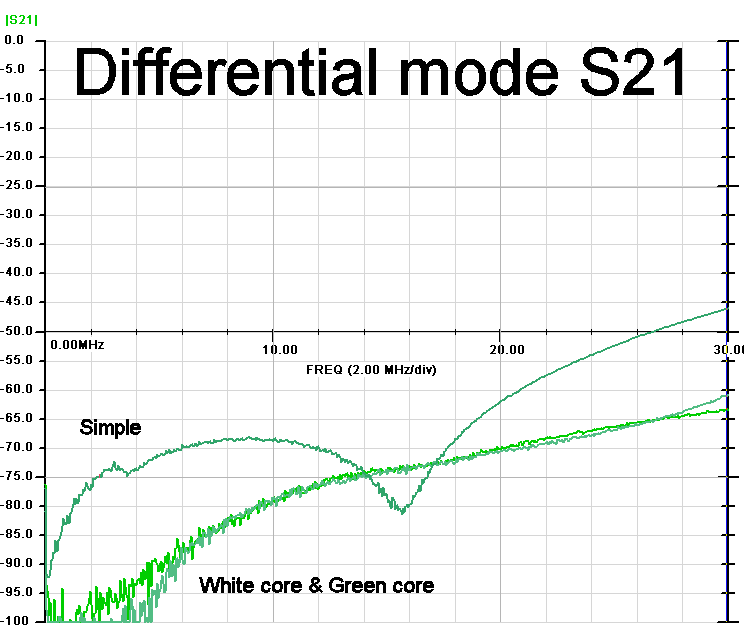G8JNJ
About
- Username
- G8JNJ
- Joined
- Visits
- 4,661
- Last Active
- Roles
- Member
- Points
- 130
Reactions
-
HT004a / LNA / Anyone used one?
Before anyone gets their credit card (or other method of payment) out. Make sure you actually need a pre-amp.
In most cases, you will not, they are useful in specific situations, but unfortunately for the majority of KiWi owners, local noise and interference will be the limiting factor, and no amount of pre-amplification or filtering, can improve or remove, what is present, and intertwined with the desired signals.
One test, I suggest, is to make a note of your receiver noise floor with a screened 50 ohm load connected in place of your antenna. Then connect your antenna, and measure the noise floor again. Typically, do this on the HF bands, in a quiet chunk of spectrum, somewhere between 25 to 30MHz.
If the difference in noise floor readings is less than 6dB, you may benefit from using a better antenna, or in some cases a pre-amplifier.
If it is 6dB or more, then your system is already noise limited by your antenna and local environment, and this may be the best you can achieve. Any further improvement can only be brought about by using a better antenna, or by reducing the amount of noise present by some other method.
If the increase in noise is 10dB or more, then it is likely that you have a lot of noise and interference present, and this will be severely limiting reception. This may be because you are using a pre-amplifier ahead of your receiver, which is probably providing too much gain, and it will not further improve the sensitivity of your receiver, but it will be degrading the overall Dynamic Range, susceptibility to overload, and generation of spurious IMD products.
Unfortunately, because of the way that natural and galactic noise is distributed across the spectrum from 100kHz to 30MHz, the noise floor at 1MHz can be 20 to 30dB higher at 1MHz with respect to 30MHz. If you add a pre-amp to improve performance on the HF bands, the likelihood is that it will be providing excessive gain on the LF bands.
Many amateur band transceivers have different attenuator and pre-amplifier settings, that are automatically changed when a different frequency range is chosen. For example, on 1.8MHz a 10dB attenuator may be applied, whereas on 28MHz a 20dB pre-amplifier may be used.
When using a KiWi, which provides continuous coverage from 0 to 30MHz, we can't use this method. So the best alternative is to use a frequency / amplitude equaliser, or shelf filter, that provides a gradually rising amount of gain with frequency (actually an increasing amount of attenuation as the frequency decreases). By doing this, we can try to match the filter characteristic, with changes in the natural noise floor, so that we only provide as much gain as necessary at any given frequency.
In a practical installation, we also have to take into account the frequency response of the antenna, and it's gain characteristics. But this usually only requires a slight modification to the filter response.
This is a link to an old article entitled "Noise equalization in h.f. receiving systems" written by D. C. Bunday, a UK GCHQ engineer, way back in 1977. It explains the concepts very clearly, along with practical circuits. Although the notes refer to problems associated with Analogue receive systems, they are equally applicable to modern day SDR's and digital Short Wave receivers.
https://www.worldradiohistory.com/UK/British-Institution-of-Radio-Engineers/1977/TREE-1977-05.pdf
Regards,
Martin
-
What an impressing radio the KiwiSDR really is.
I have said this before, but I consider the KiWi to probably be the best radio hobby related purchases I've ever made, and it has reinvigorated my interest in Short Wave listening, and utility monitoring.
Nearly every week I discover something new, or an enhancement that John has implemented. Which is in stark contrast to other developers, who often immediately dismiss legitimate requests from users and admins.
The TDoA function is a stand-out feature, that has made an otherwise difficult aspect of the hobby, IDing the location of unknown transmitters, become relatively straightforward.
I have recently swapped out my computer monitor from the 22" model I was using, to a repurposed 44" 4K TV, and it's a game changer. Being able to see a vast swathe of spectrum, in relative HD, is superb, and makes spotting unusual signals, or patterns of signals, very easy.
My sincere thanks to John for continuing to support the KiWi, despite the extremely difficult trading environment, and to all the others who have contributed in some way, it is much appreciated.
Regards,
Martin
-
Attenuators before or after the pre-amp?
Ideally, you should place attenuators between the LNA and receiver, this ensures the best overall Noise Figure.
However, there is a trade in LNA design between strong signal handling and Noise Figure.
Most cheap LNA's don't have a sufficiently good enough strong signal handling performance, and they produce Intermodulation products, which typically show up around the MW broadcast band and either side of the 160m Amateur band.
The Intermodulation performance of an amplifier is usually specified by the second and third order intercept points that are typically measured at the amplifier output. This is a theoretical value where the Intermodulation products rise at a faster rate than the original signals, and if you plot all these levels against each other, you will find points at which they intersect. Once you have such a graph, you can then work backwards, to see what maximum level the input signals can be, before the Intermodulation products start to rise above the receiver noise floor.
I use a copy of the DXE-RPA1 pre-amplifier and have measured the IOP2 at +92dBm, and the IOP3 at +45dBm, and this is just about acceptable when connected to a decent antenna.
For comparison, a single PGA-103+ amplifier (still decent, and better than most) measured an IOP2 at +48dBm, and the IOP3 at +36dBm, but this does produce noticeable IMD products.
The Kiwi typically has a Noise Figure of 14dB at 30MHz, which is just about adequate. If you add an LNA with a better noise figure, that will improve the sensitivity on the upper HF bands. But every dB of attenuation, you place before the LNA, will degrade its Noise Figure by the same amount. Placing attenuation after the LNA, does not degrade the system NF to the same extent. There are various cascade Noise Figure calculators on the web, if you wish to investigate this for yourself.
Pre-amplifiers should ideally only have enough gain to overcome any system losses. As a simple test, if you connect a 50 ohm load in place of the antenna, and note the level of the noise floor at 30MHz, then connect the antenna back up, you should aim for a 6dB increase in the level of the noise floor. Any less than this and you are missing some signals, and any more than this, you are using up the KiWi's valuable dynamic range, which is not desirable.
Regards,
Martin
-
Quiet switch mode power supply (SMPS) for KiwiSDR
I recently did a bit more research into the various DC filter boards that can be bough cheaply from China.
I've previously mentioned the simple type with two separate inductors.
Simple DC Filter
But I wanted to compare it against some of the larger types with an additional common mode choke using a dual winding. All of these seem to use the same printed circuit board, but populated with different types of inductors.
Green rectangular core common mode choke, and black core inductors
With toroidal common mode choke and yellow / white core inductors (Type 26 Iron Powder)
Differential Mode attenuation - direct noise from the power rails
All the filters are pretty effective. The simple type is slightly worse, but I doubt you would notice much difference between them in "real life"
Common mode attenuation - conducted noise, usually via a ground path
The Green and White cored filters are much more effective. The White cored filter would be slightly better at reducing low frequency <1MHz switching noise from Switched Mode Power Supplies, but the Green cored version provides much better overall attenuation.
Note that the values of attenuation were measured in a 50 ohm system, and the actual amount of attenuation will depend on the circuit impedance. However, using 50 ohms does at least provide a standard reference for comparison purposes.
Regards,
Martin
-
Maximum possible number of simultaneous users
In addition.
If you have more than the specified number of users trying to connect, the additional ones can "queue" to wait for the next free slot, or "camp" where they can "piggyback" onto an existing user and hear just the audio.
This is useful when you have a lot of users all wanting to listen to the same thing, such as a popular amateur radio net.
The maximum number of campers can be defined in the "Control" admin page.
Regards,
Martin
-
Quiet switch mode power supply (SMPS) for KiwiSDR
-
Quiet switch mode power supply (SMPS) for KiwiSDR
All the broadband routers I have had provided, have had noisy Switched Mode "Wall Wart" type power supplies as standard.
They produced far more interference than the routers, which generally tended to be of good construction and had been EMC tested as part of the design process.
The power supplies always seemed to be an afterthought, and may have been sourced differently from the actual router, depending on local electrical regulations and requirements.
It is likely that the power supplies have been chosen on the basis of cost, and we all know what happens then.
Because of their small size, it is usually not possible to add extra filtering, and such internal modifications can also result in safety and insurance issues.
I tend to look in Charity (Thift) stores or at Car Boot sales for older, cheap electronics, with separate linear power supplies. As it's difficult and expensive to buy new linear power supplies, especially since the audiophiles are willing to pay silly prices for them. The rest of the electronics are useful for parts too.
On an incidental, but related subject
A friend of mine, who allows me to host a KiWi at the historic Goonhilly satellite earth station in Cornwall UK, was good enough to resite the KiWi to a new location on the site, in an attempt to resolve some long standing interference problems. However, he couldn't get it to connect properly to the network. He could see it acquired a DHCP address, but he couldn't ping it. He then transferred the KiWi back to the original location, and it still didn't work properly.
Thinking that somehow the build had become corrupted, we arranged for him to return the KiWi to me, so that I could fix it, upgrade the OS and take the opportunity to check things like the fan (which as expected was stuck solid).
The actual fault was the Switched Mode Power supply, which seemed to be working correctly, as the output voltage was correct when checked with a multimeter, it would also still happily deliver 5A output.
However, I noticed that the output voltage dipped just a bit more than I would have expected when on load, but only by about 0.2v.
I took the power supply apart and discovered that the main high voltage DC storage capacitor (150uF at 450v) had dried out over time, and was completely open circuit. This is why the DC regulation was so poor, and also why the KiWi was having difficulties.
Replacing the capacitor fixed the problem, and the KiWi was back to working as normal.
Most of my past KiWi problems have been power supply related in one way or another, so my rule of thumb now is:-
If your KiWi is misbehaving in any way, check the power supply first, and pay close attention whilst you do it.
Regards,
Martin
-
New product accessories in our store: SDR protection circuit, MW filter
You only need sufficient attenuation to take the strongest broadcast stations down by just enough to prevent ADC overloads from occurring. I generally try to keep all signals across the 0-30MHz spectrum below -30dB.
If you have an existing band stop filter, with too much attenuation, you can connect a 1K ohm variable resistor between the input and output of the filter, and then adjust the value until you have enough attenuation to prevent overload occurring at night, but still allow some signals to pass through at a usable level.
Even on a receive site where I had strong signals from local medium wave transmitters, I've not had to introduce more than 20dB of band reject filtering to fix the problem. In most cases, a simple 10dB slope frequency / amplitude equaliser provides a good compromise.
This and other techniques have been discussed in many previous threads, so it's worth searching for those.
Regards,
Martin
-
Trying to understand this noise
Don't buy the Bonito loop.
Have a look at the Loop Antennas IO group.
https://groups.io/g/loopantennas
You will find some familiar names on there, and one or two, are offering ready built loop amplifier PCB's based on Wellbrook and LZ1AQ's designs.
My personal favourites are versions of the LZ1AQ loop amplifier. But for a bit more money, you could buy a much more versatile ready built LZ1AQ active antenna amplifier, that facilitates both switched active loop and dipole modes. This is highly effective and still costs a fraction of the Bonito (which is based around a cheap video amplifier chip).
Chavdar's other webpages are a goldmine of information and highly recommended too.
https://www.lz1aq.signacor.com/docs/lz1aq-topical-article-index.php
I hope this provides some alternative options.
Martin
-
Register Kiwi SDR online
"Many thanks, there seems to be so much to look at with so many tabs on the admin page."
There are so many user cases that it's difficult to cater for everyone. But the more you use your KiWi, the more thankful you will become that a specific feature has been included in the admin setup.
I run several different types of web sdr, and the KiWi is the one that has incorporated the most useful features and suggestions from users and admins alike.
Many other developers will simply ignore such requests, because they personally don't understand the requirement, or simply focus on the software, rather than the needs of the users.
Some other web sdr's, require you to be a Linux guru before you can get up and running, so the KiWi is pretty much "plug and play" in comparison.
Regards,
Martin




















